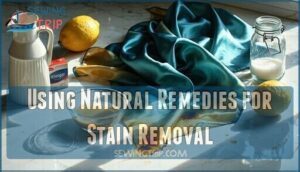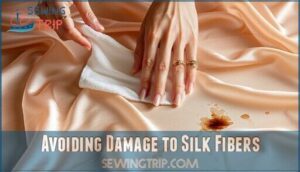This site is supported by our readers. We may earn a commission, at no cost to you, if you purchase through links.

First, blot—don’t rub—the stain with a clean white cloth to absorb excess liquid.
Rubbing pushes the stain deeper into silk’s delicate fibers.
Mix a tiny amount of mild detergent with cool water, then dab the stained area carefully.
Rinse thoroughly with cool water and lay flat to dry away from direct sunlight.
Never use hot water or harsh chemicals, as they’ll damage silk permanently.
Different stains require specific approaches, and timing matters more than you might think for successful removal.
It’s crucial to understand that successful removal depends on these factors.
Table Of Contents
- Key Takeaways
- Removing Stains From Silk Successfully
- How to Get a Stain Out of Silk Fabric
- Common Stain Removal Techniques for Silk
- Caring for Silk Garments to Prevent Stains
- When to Seek Professional Dry Cleaning for Silk
- Tips for Preventing Future Stains on Silk
- Frequently Asked Questions (FAQs)
- Conclusion
Key Takeaways
- Act fast and blot gently – You’ll prevent permanent damage by immediately blotting stains with a clean cloth instead of rubbing, which pushes stains deeper into silk’s delicate fibers.
- Use cold water and mild solutions – You should always treat silk stains with cold water and gentle detergents, as hot water and harsh chemicals will permanently damage the fabric’s protein fibers.
- Apply powder for oil stains – You can effectively remove grease by sprinkling cornstarch or talcum powder on the stain, letting it sit for 15-20 minutes to absorb oils, then brushing it off gently.
- Know when to seek professional help – You’ll save your valuable or antique silk pieces by taking them to professional dry cleaners when home treatments fail or when dealing with stubborn, set-in stains.
Removing Stains From Silk Successfully
You can’t treat silk stains the same way you handle cotton or polyester because silk’s delicate protein fibers require gentle, specific techniques to avoid permanent damage.
Success depends on acting quickly, choosing the right cleaning method for each stain type, and understanding how silk reacts to different cleaning solutions, which is crucial for success.
Time is your greatest ally when silk meets stains—act fast, choose wisely, and save your precious fabric from permanent damage.
Identifying Types of Stains
Before you tackle any silk stain, you need to play detective and identify what you’re dealing with.
Different stains require completely different battle plans.
Here’s your stain assessment checklist:
- Oil stains and grease: Look for dark, translucent spots that feel slick to touch—think cooking oil, butter, or makeup
- Protein stains: Fresh blood, sweat, or food spills often appear brownish and may smell distinct
- Dye-based stains: Wine, coffee, or ink create sharp color contrasts against silk’s natural sheen
Understanding whether you’re facing grease vs. water-based culprits, oxidized stains, or ink identification challenges determines your removal strategy and prevents costly fabric damage.
Pre-treating Silk Stains
Strike while the iron’s hot—Immediate Action is your best friend when dealing with silk stains. The moment you spot a stain, grab a clean cloth and start Gentle Blotting to prevent Stain Penetration deeper into the delicate fibers.
Strike fast, blot gently—your silk’s survival depends on those first crucial seconds after a stain appears.
For greasy stains, sprinkle cornstarch or talcum powder directly onto the spot. This Powder Absorption technique draws out oils before they set permanently. Let it sit for 15-20 minutes, then brush off gently.
Next comes Solution Application. Mix mild dish soap with cold water and test it on a hidden area first. Remember for the best results, identifying stain types is key. Dab—don’t rub—the mixture onto the stain using a soft cloth. This pretreatment step breaks down the stain’s structure, making your silk stain removal efforts more effective.
Remember, stain treatment on silk fabric requires patience. These silk stain removal tips work best when you’re gentle and methodical.
How to Get a Stain Out of Silk Fabric
Removing stains from silk fabric requires a gentle approach and quick action to prevent permanent damage.
You’ll need to blot the stain carefully, avoid rubbing the delicate fibers, and use specific techniques that work with silk’s unique properties, including gentle methods to ensure the fabric remains intact.
Blotting Vs Rubbing Stains
Blotting benefits your silk by lifting stains without pushing them deeper into delicate fibers.
Rubbing risks permanent damage and stain spreading across the fabric.
When removing stains from silk, press a clean white cloth directly onto the stain using gentle pressure.
This blotting technique prevents fiber damage that rubbing causes.
Your gentle approach to silk stain removal preserves the fabric’s integrity.
These stain removal techniques require patience, but gentle handling protects your investment while effectively lifting unwanted marks from precious silk items.
Using Natural Remedies for Stain Removal
Natural remedies offer safe, effective silk stain removal at home without harsh chemicals.
A vinegar solution mixed with equal parts water gently lifts coffee and wine stains—just dab and blot clean. Lemon juice works like nature’s bleach for light fabrics, while baking soda absorbs fresh grease spots naturally.
Talcum powder pulls oil from delicate fibers overnight. Avoid sunlight exposure during treatment, as it can fade silk’s natural sheen.
These silk stain removal DIY methods protect your precious fabrics. For best results, remember to blot up liquids immediately.
Avoiding Damage to Silk Fibers
Since silk fibers are incredibly delicate, you’ll need to handle them like precious jewelry. One wrong move can spell disaster for your favorite piece.
A key step involves understanding how to get a stain out of silk.
- Use gentle handling with soft dabbing motions instead of abrasive methods
- Choose safe detergents with neutral pH to prevent fabric damage
- Avoid heat during cleaning and drying to protect delicate fabric integrity
Common Stain Removal Techniques for Silk
You’ll face different stains on silk that require specific removal methods to protect the delicate fibers.
Each stain type, from oil and grease to wine and makeup, needs its own targeted approach using gentle techniques and safe cleaning solutions.
Removing Oil and Grease Stains
When oil meets silk, time becomes your enemy. Act fast to save your precious fabric from permanent damage.
Start with gentle blotting using a clean cloth to absorb excess oil without spreading the stain. Next, apply absorbent powders like talcum powder or cornstarch directly onto the grease. These pre-treatment steps are essential for oil absorption.
Cover the powder with cloth, press lightly, and let it sit overnight to draw out deeper oils. Brush off residue in the morning. For stubborn cooking oil stains, create a dish soap solution with lukewarm water and gently work it into the fabric.
Always test stain types on hidden areas first. Repeat these gentle blotting techniques if needed. Some people have had success removing cheese stains effectively using specific techniques.
Removing Wine Stains
When red wine meets silk, time becomes your enemy.
Immediately blot with a clean cloth—never rub. Sprinkle salt to absorb the liquid, then brush away after ten minutes.
For stubborn old stains, create a gentle solution using white wine or cold water with mild detergent.
Different silk types require specific silk stain removal methods. These proven stain removal tips work better than harsh stain remover products that damage delicate fibers.
Removing Makeup and Ink Stains
Makeup and ink stains don’t have to spell disaster for your silk fabric. Quick action makes all the difference with these silk stain removal methods.
Here’s your game plan:
- Blot immediately with clean cloth—never rub or you’ll spread the damage
- Test makeup remover on hidden area first to prevent fabric damage
- Use hairspray for fresh ink stains, then dab gently
- Try rubbing alcohol on stubborn ink marks using cotton swab
- Consider stain age—older stains need professional silk stain solutions
Removing Water Stains
Water stains on silk fabric appear as rings or spots after moisture evaporates.
You’ll need distilled water and gentle blotting motions for effective water ring removal. Don’t rub—this damages delicate fibers.
| Method | Best For |
|---|---|
| Steam treatment | Light watermarks |
| Vinegar solution | Stubborn rings |
| Professional cleaning | Valuable items |
Apply distilled water around the stain’s edges, working inward. Steam helps loosen stubborn marks.
For persistent stains, mix equal parts white vinegar and distilled water. These silk drying methods prevent future watermarks while preserving your fabric’s integrity.
Caring for Silk Garments to Prevent Stains
Prevention is always better than cure in the context of silk stain management.
You’ll save time, money, and stress by establishing proper care routines that protect your silk garments from common staining situations before they occur, which is a key aspect of prevention.
Washing and Drying Silk
Proper silk washing starts with cold water and silk detergents designed for delicate fabrics.
Your silk washing machine should use gentle cycles, but hand washing remains safest.
Never wring wet silk—press water out gently with towels.
For silk drying, lay garments flat away from heat sources to prevent shrinkage and maintain fabric integrity.
- Water temperature matters: Cold water preserves silk’s natural proteins while hot water causes irreversible damage and shrinkage
- Silk washing precautions: Turn garments inside out and use mesh bags when machine washing to prevent snags
- Drying methods vary: Air drying flat prevents stretching while hanging can distort delicate silk fibers permanently
- Silk care instructions: Press out excess water with clean towels instead of wringing to maintain fabric structure
- Storage solutions: Fold dried silk loosely or hang on padded hangers to prevent creasing and fiber stress
Avoiding Direct Sunlight
Sunlight acts like bleach on silk fabric, causing irreversible fading and fiber degradation that weakens your garments.
Color preservation requires smart indirect drying strategies to maintain silk’s natural beauty.
- Indoor Drying: Hang silk away from windows in well-ventilated rooms for fading prevention.
- Shade Protection: Use covered patios or shaded outdoor areas for natural air circulation.
- Safe Storage: Keep silk garments in dark closets between wears.
Storing Silk Garments Properly
Smart storage protects your silk investments from damage and stains.
Choose breathable storage over plastic bags to prevent moisture buildup.
Folding vs hanging depends on weight—lightweight pieces fold well with acid-free paper, while structured garments need padded silk hangers.
Fabrics should also be stored in areas that maintain stable temperatures to prevent damage.
| Storage Method | Best For | Protection Level |
|---|---|---|
| Silk garment bag | Travel, short-term | Medium |
| Cedar storage boxes | Long-term, moth prevention | High |
| Humidity control containers | Vintage pieces | Maximum |
These silk storage tips guarantee fabric preservation and stain prevention.
Handling Silk With Care
Your silk deserves gentle handling every time you touch it.
Fold carefully to prevent creases, and keep sharp objects away from this delicate fabric.
Skip wire hangers that stretch fibers—use padded ones instead for fiber protection.
These preventative measures stop damage before it starts.
Following proper silk care tips guarantees your garments maintain their beauty and silk longevity for years.
When to Seek Professional Dry Cleaning for Silk
You’ll know it’s time to call a professional dry cleaner when your silk garment has stubborn stains that won’t budge after gentle home treatment.
Or when you’re dealing with expensive or sentimental pieces you can’t risk damaging.
Professional cleaners have specialized solvents and techniques that can safely remove tough stains from delicate silk fibers without causing shrinkage, color loss, or texture damage.
Identifying Delicate or Valuable Items
Determining which silk items need professional care isn’t guesswork. You’ll save yourself heartache by recognizing valuable pieces before attempting DIY stain removal.
Here’s how to identify items requiring expert handling:
- Antique Silk pieces over 50 years old with fragile fibers
- Designer Labels from luxury brands like Hermès or Chanel
- Fiber Content tags showing pure silk or silk blends
- Weave Structure displaying intricate patterns or delicate construction
- Damage Assessment revealing existing wear or previous repairs
Recognizing Stubborn Stains
Persistence separates manageable stains from professional-level challenges.
You’ll recognize stubborn stains by their refusal to fade despite multiple silk stain removal techniques and products.
| Factor | Signs of Stubbornness | Action Needed |
|---|---|---|
| Stain Age | Set for days/weeks | Professional assessment |
| Fiber Type | Delicate weave damaged | Specialized treatment |
| Stain Composition | Oil, ink, wine deeply embedded | Expert silk stain removal products |
| Previous Attempts | Multiple failed treatments | Stop DIY efforts |
| Setting Factors | Heat/time worsened stain | Professional intervention |
When stain persistence defeats stain removal effectiveness, it’s professional time.
Addressing stains promptly can prevent them from becoming permanent, but sometimes you need to know how to get a stain out of silk.
Finding a Professional Dry Cleaner
When choosing a professional cleaning service for silk stain removal, focus on three key factors:
- Dry Cleaner Reputation – Check online reviews and ask well-dressed colleagues for recommendations
- Certification Matters – Look for affiliations with the Drycleaning & Laundry Institute
- Specialized Services – Verify they handle delicate fabrics with silk stain removal professional expertise
Compare silk stain removal cost and Turnaround Time before selecting your dry cleaner.
Tips for Preventing Future Stains on Silk
Protecting your silk garments from stains is far easier than removing them after they’ve set in.
You can extend your silk’s life and maintain its beauty by applying fabric protector spray, washing items regularly, and choosing the right detergent for delicate fibers, which helps in protecting your silk garments and maintaining their life.
Applying Fabric Protector Spray
Regularly applying fabric protector designed for delicate fabric creates an invisible shield on your silk fabric.
Choose products with silk compatibility to maintain breathability impact while boosting stain resistance.
Test spray application on hidden areas first.
Protector lifespan typically lasts 3-6 washes, so reapply consistently.
Consider using a dedicated silk protector for best results.
This fabric protection method prevents most spills from penetrating fibers, making future stain prevention effortless.
Washing Silk Regularly
Beyond fabric protection, consistent washing prevents stains from becoming permanent fixtures on your silk.
Regular cleaning maintains the fabric’s natural oils and prevents buildup that attracts dirt and grime.
Smart silk washing frequency keeps your garments pristine:
- Weekly washing for frequently worn silk items like blouses and scarves
- Monthly cleaning for occasional-wear pieces like silk dresses or jackets
- After each wear for undergarments and items exposed to sweat or perfume
- Seasonal washing for stored silk items before putting them away
- Immediate cleaning when you notice any spots or odors developing
Using a Mild Detergent
You need mild detergent with neutral detergent pH levels for proper silk fabric care.
Harsh chemicals destroy delicate fibers, making silk stain removal harder later.
Choose detergents specifically designed for delicate fabric cleaning to guarantee silk fiber protection.
Use gentle agitation methods with cold water effectiveness during washing.
Always rinse thoroughly for residue-free rinsing when cleaning silk fabric.
Frequently Asked Questions (FAQs)
Can stains on silk be removed?
Yes, you can remove stains from silk with quick action.
Blot immediately, apply cornstarch or talcum powder to absorb oils, then use mild dish soap with cold water.
Gentle handling prevents fiber damage.
What is the best stain remover for silk ties?
Ironically, expensive silk ties demand the gentlest touch.
You’ll want mild dish soap mixed with cold water as your go-to stain fighter.
Blot don’t rub, test first on hidden areas, and air dry completely.
How to get a make-up stain out of silk?
Dab makeup stains with silk-safe makeup remover, testing on a hidden area first.
Gently blot from the center outward with a clean cloth.
Don’t rub or you’ll spread the stain further into delicate fibers, this is a delicate process.
Can baking soda remove stains on silk?
Like a gentle eraser on paper, baking soda can lift stains from silk when used carefully.
Make a paste with water, apply gently, let sit briefly, then rinse with cold water and air dry.
How do you remove stains from silk?
Blot fresh stains gently with a clean cloth, then sprinkle cornstarch to absorb oil.
Let it sit for 15-20 minutes before brushing off.
Use cold water and mild soap for stubborn stains.
How do you remove perspiration stains from silk?
Mix equal parts white vinegar and cold water in a bowl.
Gently dab the perspiration stain with this solution using a clean cloth.
Rinse with cold water, then air dry away from direct sunlight.
How do you remove sweat stains from silk?
Treat sweat stains on silk immediately by gently blotting with cold water.
Create a solution using mild dish soap and cold water, then dab the stain.
Rinse carefully and air dry away from direct sunlight.
How do you remove stains from silk shirts?
That stubborn stain doesn’t have to spell doom for your favorite silk shirt.
First, you’ll blot gently with a clean cloth, then apply cornstarch to absorb oils before washing with cold water and mild detergent.
What happens if you remove a stain from silk?
When you successfully remove a stain from silk, you’ll restore the fabric’s original appearance and luster.
Proper removal preserves the delicate fibers, maintaining smoothness and preventing permanent damage or discoloration to your garment, which helps in preserves the overall quality.
How do you remove blood stains from silk fabric?
Blood stains on silk require immediate cold water treatment.
Rinse gently with cold water, then apply a mixture of cold water and mild dish soap.
Blot carefully, rinse again, and air dry completely.
Conclusion
Like Cinderella’s delicate glass slipper, silk requires gentle handling to maintain its beauty.
You’ve learned how to get a stain out of silk 2 through proper blotting techniques, natural remedies, and careful treatment methods.
Remember that timing is everything—act quickly but never rush the process.
When you follow these expert techniques, you’ll preserve your silk’s luxurious appearance for years.
However, don’t hesitate to seek professional dry cleaning for valuable items or stubborn stains that resist home treatment, which may require specialized care.
















